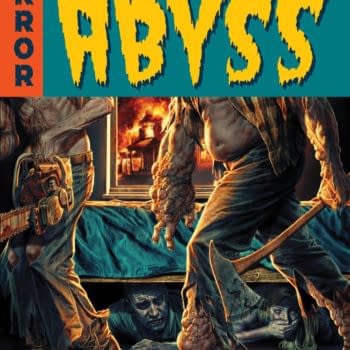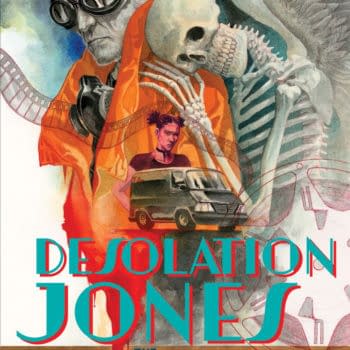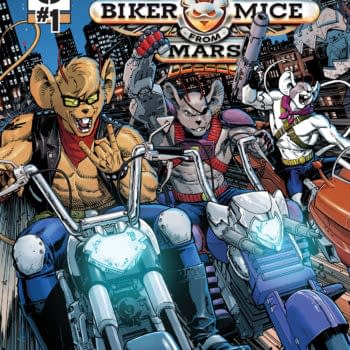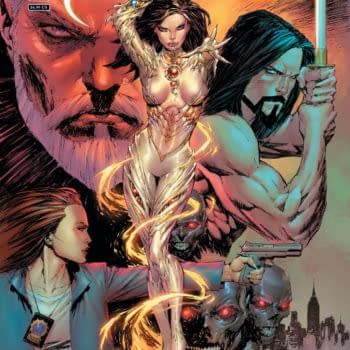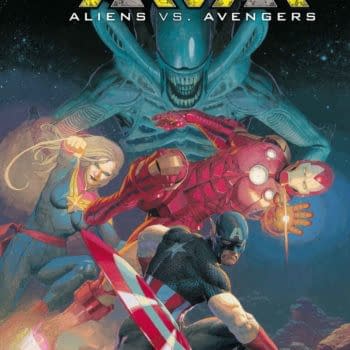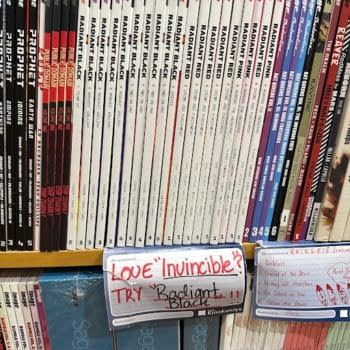Posted in: Comics, Recent Updates | Tagged: Baltimore Comic Con 2013, gabriel rodriguez, idw, interview, joe hill, Locke & Key, Seth Kushner
"Locke & Key is to Sandman what Mini-Me is to Doctor Evil" – Joe Hill Talks To Bleeding Cool About Comics – Photos By Seth Kushner
The publication history of Locke & Key has become almost as legendary as the comic series' contents, rocketing into sold-out status on the very first day of the first issue's release in 2008. Since then, New York Times Best-Selling author Joe Hill and artist and illustrator Gabriel Rodriguez have intricately crafted thirty-two issues of the gripping, heartfelt, horror comic, now in its final two issues: "Alpha #1" and "Alpha #2". Meanwhile, Hill has added to his oeuvre by producing another best-selling novel, NOS4A2, and is heralding the publication of his related comic mini-series WRA1TH, also with Rodriguez. In the midst of what seemed like a storm of creative furor, Hill descended on Baltimore Comic Con to participate in some panels and sign for what can only be described as starry-eyed hoards of book-toting fans.
Courtesy of IDW, Hill sat down with Bleeding Cool to discuss his future plans and his take on storytelling in comics. Seth Kushner, award-winning photographer and visual dynamo behind the photo-profile book Leaping Tall Buildings, joined us to concoct some of the most striking portraits of Hill that you're ever likely to see. As Kushner snapped these images on the floor at Baltimore Comic Con, a capped line of avid Hill-readers waiting for the signing clapped and cheered at Hill's antic poses. With Locke & Key poised for completion, this also signals a unique point in Hill's career as he pauses to take a breather from comics but firmly intends to return to what he calls a "very collaborative medium".
Hannah Means-Shannon: You've talked a little bit before about Sandman and Swamp Thing being big influences on your work in comics. Is Locke & Key your Sandman in the sense that it's a big world that you've created and now you don't really need to do any more large, long-form projects?
Joe Hill: I have about ten percent as much talent as Neil Gaiman. Locke & Key is to Sandman what Mini-Me is to Doctor Evil. But I adore Sandman and I adore Y: The Last Man, and I adore a lot of other comics with "man" in the title. And I wanted to have my own long running "man". So that's where I came up with "Locke & Key Man". IDW made me change the title. I'm still angry about it, but we went with that. So we've done that. I feel like 37 issues is a pretty big world and there's going to be some more, eventually.
To be honest, though, Gabe and I already have an idea for a different kind of fantasy-story world-thing, which actually also won't have "man" in the title, unfortunately. And we're going to do that, and that will be another long running series eventually. We're going to do it, though it might be a year, or two years, or even three before we get around to doing it. Because I'm taking a little time off from comics.
HMS: So, you are interested in creating more comics universes?
JH: Yeah, I've had an idea now that Gabe and I started kicking around about eighteen months ago and I'm very excited about it. If Locke & Key is "R" rated, this is hopefully going to be a little more PG-13, but sometimes it's tough to control myself. I don't have good habits in that way. I have wanted to write something that maybe the kids could kind of read without shame, and this is a little like that, but still kind of dark, actually, and it is a different, big, fantasy thing. And the only question that Gabe and I have had is, "Do we write the whole thing or do we just do the first ten issues and then let someone else take over?" I don't know. But it is a long running thing. And in some ways it is a little more open-ended than Locke & Key.
HMS: What do you think that comics can do differently from any other medium?
JH: I think that when novelists try to write comics, they often fail because they imagine somehow that comics are illustrated books. And they're not. Most of the most powerful moments in comics are implied, not shown. I think about a panel that Gabe did in Locke & Key "Omega 2", when a young disabled boy named Rufus Whedon realizes that Bodie is in fact the demon Dodge and attempts to kill him, but it looks like he's attacking a child. And Tyler Locke, who has always done the heroic thing, does the heroic thing again. You have this awful panel of Tyler grabbing his shoulder and reaching back with a tire iron, and when you turn the page, Rufus is in the back of a car and he's got ten stitches in the side of his face. And it's horribly painful. But you didn't actually see the painful thing. That was implied. And one of the things that comics does well is provide a series of iconic moments and then allows the audience to tell the rest of the story for themselves.
Sometimes I think that comics routinely do what was so wonderful about Star Wars when Star Wars first started to come out. When Star Wars first started, there were three years between Star Wars and The Empire Strikes Back. And there was room for you to tell your own story. And that was half the fun. And the reason why Star Wars wound up sucking was because George Lucas couldn't let us tell our stories. He had to step all over our stories and tell his. And when he filled in the blanks, it was never as good as what we were imagining filled in the blanks. And comics, in between issues, and in between panels, routinely invites the audience to fill in the rest, to tell their stories. And in that way it's a very collaborative medium.
There are some other things you can do with comics like schematics, and diagrams, and lists, and posters. I think the most brilliant page in comics in the last ten years was in Wednesday Comics. It was when Neil Gaiman did a page for Metamorpho, drawn by Mike Allred, where Metamorpho was fighting his way through the Table of Elements. You couldn't do it in a movie. You couldn't do it in a TV show, and you couldn't do it in a novel. You could only do it in a comic book. And that kind of understanding the form, and then using it to create something new and fresh, is what really excites me about comics.
HMS: A massive thank you to IDW and to Joe Hill for taking the time to chat with Bleeding Cool and to Seth Kushner for providing his astonishing photography to accompany this interview.
Seth Kushner's photography has appeared in The New York Times Magazine, Time, Newsweek, The New Yorker, and others. He was chosen by Photo District News Magazine as one of their 30 under 30 in 1999 and is a three-time winner of their Photo Annual Competition. Seth's first book, The Brooklynites (with Anthony Lasala) was published by Powerhouse Books in 2007. His second book, Leaping Tall Buildings: The Origins of American Comics (with Chris Irving) was released in 2012 by Power House Books. TripCity.net is the current home of Seth's profile series CulturePOP Photocomix, and his comix series Schmuck. Seth resides in his hometown of Brooklyn, NY, with his wife, son, and way too many cameras and comics. All photos of Joe Hill in this article remain copyright Seth Kushner.
Hannah Means-Shannon is senior New York Correspondent at Bleeding Cool, writes and blogs about comics for TripCity.net and Sequart.org, and is currently working on books about Neil Gaiman and Alan Moore for Sequart. She is @hannahmenzies on Twitter and hannahmenziesblog on WordPress. Find her bio here.
















